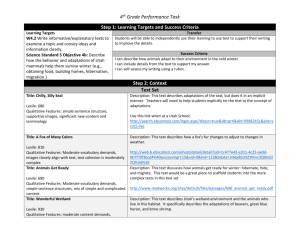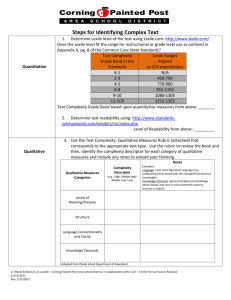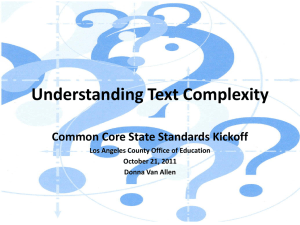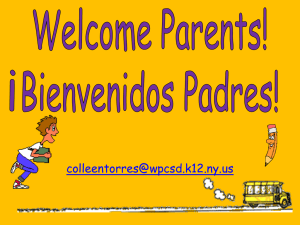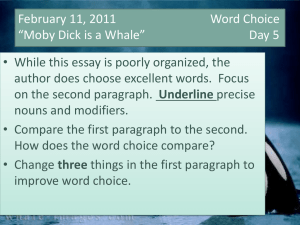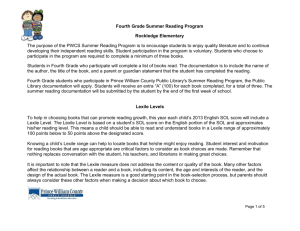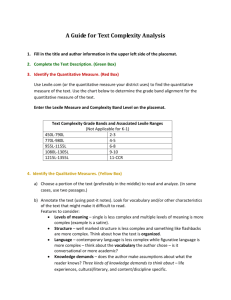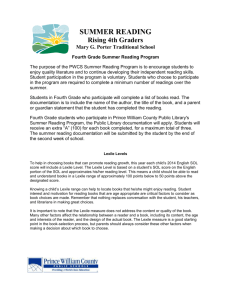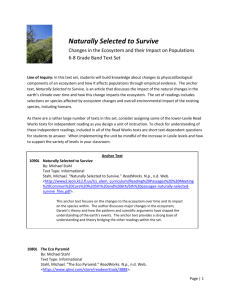Performance Task Development Template
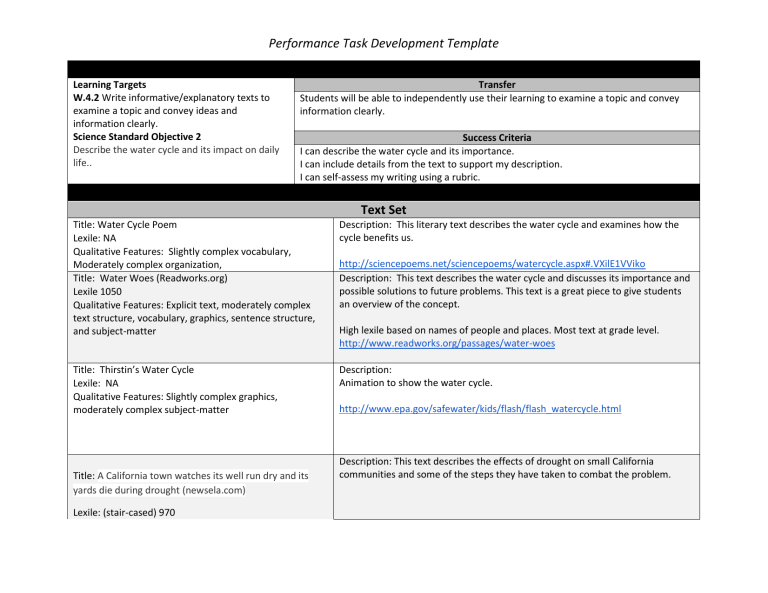
Performance Task Development Template
Step 1: Learning Targets and Success Criteria
Learning Targets
W.4.2 Write informative/explanatory texts to examine a topic and convey ideas and information clearly.
Science Standard Objective 2
Describe the water cycle and its impact on daily life..
Transfer
Students will be able to independently use their learning to examine a topic and convey information clearly.
Success Criteria
I can describe the water cycle and its importance.
I can include details from the text to support my description.
I can self-assess my writing using a rubric.
Step 2: Context
Title: Water Cycle Poem
Lexile: NA
Qualitative Features: Slightly complex vocabulary,
Moderately complex organization,
Title: Water Woes (Readworks.org)
Lexile 1050
Qualitative Features: Explicit text, moderately complex text structure, vocabulary, graphics, sentence structure, and subject-matter
Title: Thirstin’s Water Cycle
Lexile: NA
Qualitative Features: Slightly complex graphics, moderately complex subject-matter
Title: A California town watches its well run dry and its yards die during drought (newsela.com)
Text Set
Description: This literary text describes the water cycle and examines how the cycle benefits us. http://sciencepoems.net/sciencepoems/watercycle.aspx#.VXilE1VViko
Description: This text describes the water cycle and discusses its importance and possible solutions to future problems. This text is a great piece to give students an overview of the concept.
High lexile based on names of people and places. Most text at grade level. http://www.readworks.org/passages/water-woes
Description:
Animation to show the water cycle. http://www.epa.gov/safewater/kids/flash/flash_watercycle.html
Description: This text describes the effects of drought on small California communities and some of the steps they have taken to combat the problem.
Lexile: (stair-cased) 970
Qualitative Features: Moderately complex purpose, organization, sentence structure, and subject-matter, slightly complex vocabulary
Title: After the Floods (Readworks.org)
Lexile: 760
Qualitative Features: Slightly complex meaning, Slightly complex text structure, moderately complex language features, slightly complex knowledge demands.
Title: Where’s the Water?
Lexile: 940
Qualitative Features: Very complex text structure, Slightly complex purpose, moderately complex language features, moderately complex knowledge demands. https://newsela.com/articles/waterless-communities/id/5418/ (newsela)
Description: This text examines flooding in Pakistan and how people are affected, as well a description of why recovery from natural disasters is a slow process in poor countries. http://www.readworks.org/passages/after-floods
Description: This text describes water and the issues people face in Central
California when droughts take over. Powerful text for quotes that could be inserted into an informative piece. http://search.ebscohost.com/login.aspx?direct=true&db=prh&AN=100888116&si te=ehost-live
Step 3: Performance Task
After reading “Where’s the Water?”, “ Water Cycle Poem”, “Water Woes”, “A California Town”, “After the Floods”, and “Thirstin’s Water
Cycle”, write an informational essay that describes how the water cycle impacts daily life. Support your response with evidence from the texts. Report on the topic using the scoring guide.
Step 4: Scoring Guide
Performance Criteria
Focus and Organization
W.4.2a, W.4.2d
4
Beyond Standard
Responds skillfully to all parts of the prompt.
Demonstrates a strong understanding of topic/text(s)
Controlling idea or main idea of a topic is focused, clearly stated, and strongly maintained
3
Meeting Standard
Responds to all parts of the prompt.
Demonstrates sufficient understanding of topic/text(s)
Focus is clear and for the most part maintained, though some loosely related material may be present
2
Approaching Standard
Responds to most parts of the prompt.
Demonstrates limited understanding of topic/text(s)
May be clearly focused on the controlling or main idea, but is insufficiently sustained
1
Not Yet Meeting
Standard
Responds to some or no parts of the prompt.
Demonstrates little to no understanding of topic/text(s)
Use of evidence from the source material is minimal, absent, in error, or irrelevant
Evidence and Elaboration
W.4.2b
Transitions
W.4.2c
Conclusions
W.4.2e
Speaking and Listening
SL.4.4, SL.4.5
Logically groups related information into paragraphs or sections, including formatting.
The response provides thorough and convincing support/evidence for the controlling idea or main idea that includes the effective use of sources, facts, definitions, concrete details, quotations, or other information and examples
Seamlessly embeds the use of precise language and domain-specific vocabulary
Use linking words and phrases skillfully to connect ideas within categories of information.
Effective, insightful conclusion related to information presented.
Reports on the topic in a highly organized manner , uses appropriate facts and relevant, descriptive details to support main ideas; uses visual displays throughout
Groups related information into paragraphs or sections, including formatting (e.g., headings)
The response provides adequate support/evidence for controlling idea or main idea that includes the use of sources, facts, definitions, concrete details, quotations, or other information and examples
Uses precise language and domain-specific vocabulary
Uses linking words and phrases appropriately to connect ideas within categories of information.
An adequate conclusion related to information presented.
Reports on the topic in an organized manner , uses some appropriate facts and relevant, descriptive details to support main ideas; uses some visual displays and often speaks
Grouping of ideas lacks cohesion (e.g., list-like, rambling, or repetitive)
The response provides uneven, cursory support/ evidence for the controlling idea or main idea that includes partial or uneven use of sources, facts, definitions, concrete details, quotations, or other information and examples
Uses little precise language and/or domainspecific vocabulary
Attempts to use some linking words and phrases to connect ideas.
Does not group related information together
The response provides minimal support/evidence for the controlling idea or main idea that includes little or no use of sources, facts, definitions, concrete details, quotations, or other information and examples
Precise language and/or domain-specific vocabulary is absent
Uses no linking words or phrases.
Conclusion, if present, is weak and/or is not related to the information presented.
Reports on the topic in a partially organized
manner, uses little or no facts and relevant, descriptive details to
support main ideas; uses
Conclusion is not present.
Reports on the topic in a disorganized manner, with no facts and uses irrelevant, nondescriptive descriptive details that provide no support to the main
and speaks clearly at an understandable pace.
clearly at an understandable pace.
Step 5: Review and Revisit
no visual displays and doesn’t speak clearly.
ideas; uses no visual
displays and doesn’t speak clearly.

